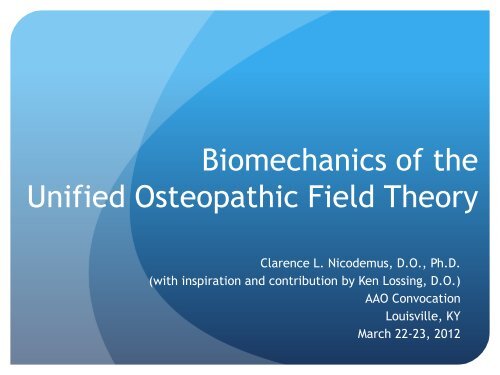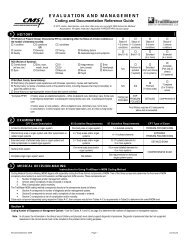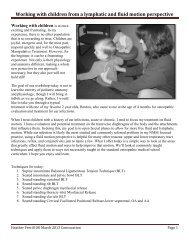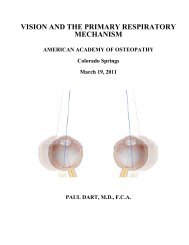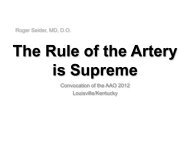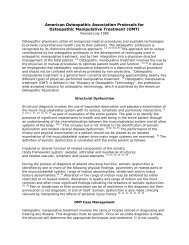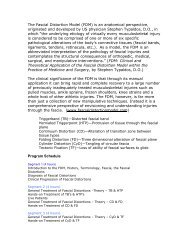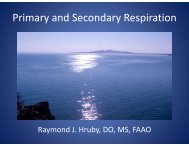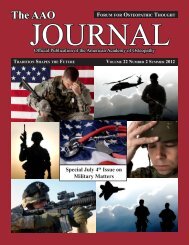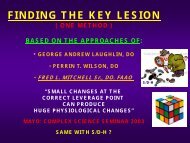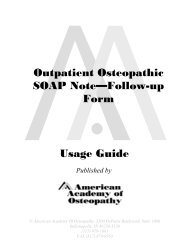Unified Osteopathic Field theory - American Academy of Osteopathy
Unified Osteopathic Field theory - American Academy of Osteopathy
Unified Osteopathic Field theory - American Academy of Osteopathy
Create successful ePaper yourself
Turn your PDF publications into a flip-book with our unique Google optimized e-Paper software.
Biomechanics <strong>of</strong> the<br />
<strong>Unified</strong> <strong>Osteopathic</strong> <strong>Field</strong> Theory<br />
Clarence L. Nicodemus, D.O., Ph.D.<br />
(with inspiration and contribution by Ken Lossing, D.O.)<br />
AAO Convocation<br />
Louisville, KY<br />
March 22-23, 2012
Examine the components:<br />
“<strong>Osteopathic</strong> <strong>Field</strong>”<br />
“<strong>Unified</strong>”<br />
“Biomechanics”<br />
Biomechanics <strong>of</strong> the <strong>Unified</strong> <strong>Osteopathic</strong> <strong>Field</strong><br />
March 22-23, 2012 C. L. Nicodemus, DO, PhD<br />
2
It all starts with Dr. Still. He was:<br />
An original<br />
Unique<br />
Creative<br />
A Visionary<br />
Correct<br />
“_____________________________________”<br />
March 22-23, 2012 C. L. Nicodemus, DO, PhD<br />
3
The “<strong>Osteopathic</strong> <strong>Field</strong>”<br />
Commonly “Taught”<br />
Approaches<br />
HVLA<br />
Muscle Energy<br />
My<strong>of</strong>ascial Release<br />
Strain/Counterstrain<br />
S<strong>of</strong>t Tissue<br />
Lymphatics<br />
“Other” Common Approaches<br />
• Balanced Ligamentous<br />
Tension and Ligamentous<br />
Articular Strain<br />
• Facilitated Positional<br />
Release<br />
• <strong>Osteopathy</strong> in the Cranial<br />
<strong>Field</strong><br />
• Progressive Inhibition <strong>of</strong><br />
Neuromuscular Structures<br />
• Functional Technique<br />
• Visceral Manipulation<br />
• Still Technique<br />
• Chapman’s Approach<br />
• Fulford Percussion<br />
• Energy<br />
Chila, Anthony. Foundations <strong>of</strong> <strong>Osteopathic</strong> Medicine, 3rd Edition. Lippincott Williams & Wilkins, 2010<br />
March 22-23, 2012 C. L. Nicodemus, DO, PhD<br />
4
<strong>Unified</strong> <strong>Field</strong> Theory<br />
Einstein's attempt to unify the General Theory <strong>of</strong><br />
Relativity with electromagnetism<br />
Wrong <strong>Field</strong> Theory<br />
March 22-23, 2012 C. L. Nicodemus, DO, PhD<br />
5
<strong>Unified</strong> <strong>Osteopathic</strong> <strong>Field</strong> Theory<br />
All theories <strong>of</strong> manual medicine are based on<br />
manipulating the same basic human tissues.<br />
Further, all human tissues exhibit the same fundamental<br />
biomechanical property, namely, viscoelasticity.<br />
March 22-23, 2012 C. L. Nicodemus, DO, PhD<br />
6
Many different aspects/models<br />
Fascial Model- Distensability, tested with motion testing<br />
and fascial pull.<br />
Fluid model- circulation, tested with doppler ultrasound,<br />
perfusion studies, or palpation.<br />
Neurological Model- electrochemical information, tested<br />
with palpation and motion testing, EMG.<br />
Biomechanical Model- Inherent and induced-Tested with<br />
palpation, ROM, sensing<br />
Energetic Model- temperature changes, electricity,<br />
etc….<br />
March 22-23, 2012 C. L. Nicodemus, DO, PhD<br />
7
What is common among these<br />
approaches?<br />
Commonly “Taught”<br />
Approaches<br />
HVLA<br />
Muscle Energy<br />
My<strong>of</strong>ascial Release<br />
Strain/Counterstrain<br />
S<strong>of</strong>t Tissue<br />
Lymphatics<br />
“Other” Common Approaches<br />
• Balanced Ligamentous<br />
Tension and Ligamentous<br />
Articular Strain<br />
• Facilitated Positional<br />
Release<br />
• <strong>Osteopathy</strong> in the Cranial<br />
<strong>Field</strong><br />
• Progressive Inhibition <strong>of</strong><br />
Neuromuscular Structures<br />
• Functional Technique<br />
• Visceral Manipulation<br />
• Still Technique<br />
• Chapman’s Approach<br />
• Fulford Percussion<br />
• Energy<br />
March 22-23, 2012 C. L. Nicodemus, DO, PhD<br />
8
Hands and Tissues (and more)<br />
It is called Manipulative Medicine because hands<br />
manipulate tissues<br />
We also engage our mind, energy, intuition, spirit<br />
It is very difficult to measure the latter<br />
So we focus on the former<br />
March 22-23, 2012 C. L. Nicodemus, DO, PhD<br />
9
Biomechanics<br />
“the application <strong>of</strong> mechanical laws<br />
to living structures.”<br />
Saunders Comprehensive Veterinary<br />
Dictionary, 3 ed. © 2007 Elsevier, Inc.<br />
March 22-23, 2012 C. L. Nicodemus, DO, PhD<br />
10
Fundamental Biomechanics<br />
Review<br />
March 22-23, 2012 C. L. Nicodemus, DO, PhD<br />
11
Histology <strong>of</strong> Connective Tissue<br />
Ken Lossing, D.O. personal correspondence<br />
March 22-23, 2012 C. L. Nicodemus, DO, PhD<br />
12
Origin and Classes <strong>of</strong> Connective<br />
Tissue<br />
http://classes.midlandstech.edu/carterp/Courses/bio210/chap04/<br />
March 22-23, 2012 C. L. Nicodemus, DO, PhD 13
Molecular<br />
Structure <strong>of</strong><br />
Collagen<br />
•Elongated<br />
•Linear<br />
March 22-23, 2012<br />
http://classes.midlandstech.edu/carterp/Courses/bio210/chap04/<br />
C. L. Nicodemus, DO, PhD 14
Other Components<br />
March 22-23, 2012<br />
http://classes.midlandstech.edu/carterp/Courses/bio210/chap04/<br />
C. L. Nicodemus, DO, PhD 15
Loose, areolar Connective Tissue<br />
March 22-23, 2012<br />
http://classes.midlandstech.edu/carterp/Courses/bio210/chap04/<br />
C. L. Nicodemus, DO, PhD 16
Loose, adipose Connective Tissue<br />
March 22-23, 2012<br />
http://classes.midlandstech.edu/carterp/Courses/bio210/chap04/<br />
C. L. Nicodemus, DO, PhD 17
Loose, recticular Connective Tissue<br />
March 22-23, 2012<br />
http://classes.midlandstech.edu/carterp/Courses/bio210/chap04/<br />
C. L. Nicodemus, DO, PhD 18
Dense, regular Connective Tissue<br />
March 22-23, 2012<br />
http://classes.midlandstech.edu/carterp/Courses/bio210/chap04/<br />
C. L. Nicodemus, DO, PhD 19
Dense, irregular Connective Tissue<br />
March 22-23, 2012<br />
http://classes.midlandstech.edu/carterp/Courses/bio210/chap04/<br />
C. L. Nicodemus, DO, PhD 20
Types <strong>of</strong> Connective Tissue<br />
Ken Lossing, D.O. personal correspondence<br />
March 22-23, 2012 C. L. Nicodemus, DO, PhD<br />
21
Fascia<br />
The fascia is a loose, areolar connective tissue<br />
composed <strong>of</strong>:<br />
collagen-( literally glue –making) 14 types , most<br />
common is type 1 (90%)<br />
ground substance<br />
fibrin<br />
Elastin- maintains the tensile strength <strong>of</strong> connective<br />
tissue<br />
The collagen fibers are connected to other collagen<br />
fibers through chemical bonds.<br />
March 22-23, 2012 C. L. Nicodemus, DO, PhD<br />
22
Effects <strong>of</strong> loading<br />
Chila, Anthony. Foundations <strong>of</strong> <strong>Osteopathic</strong> Medicine, 3rd Edition. Lippincott Williams & Wilkins, 2010<br />
March 22-23, 2012 C. L. Nicodemus, DO, PhD<br />
23
Collagen Structure<br />
Chila, Anthony. Foundations <strong>of</strong> <strong>Osteopathic</strong> Medicine, 3rd Edition. Lippincott Williams & Wilkins, 2010<br />
March 22-23, 2012 C. L. Nicodemus, DO, PhD<br />
24
Muscle Fiber Structure<br />
Chila, Anthony. Foundations <strong>of</strong> <strong>Osteopathic</strong> Medicine, 3rd Edition. Lippincott Williams & Wilkins, 2010<br />
March 22-23, 2012 C. L. Nicodemus, DO, PhD<br />
25
Terminology<br />
terminology [tur-muh-nol-uh-jee]<br />
March 22-23, 2012 C. L. Nicodemus, DO, PhD<br />
26
Strain and Stress<br />
Strain: is a measure <strong>of</strong> the degree or intensity <strong>of</strong><br />
deformation. Elongation per unit gage length. Units <strong>of</strong><br />
strain – mm/mm, in/in STRAIN = ΔL/L<br />
Stress: force per unit area, may be shear stress, tensile<br />
stress, or compressive stress. Units <strong>of</strong> stress- N/m 2<br />
(pascal), dyn/cm 2 , lbs/in 2 . STRESS=F/A<br />
Shear stress is a “cross fiber” action. Units <strong>of</strong> stress-<br />
N/m 2 (pascal), dyn/cm 2 , lbs/in 2. SHEAR STRESS = F ’ /A<br />
March 22-23, 2012 C. L. Nicodemus, DO, PhD<br />
27
Elastic Deformation<br />
Stress<br />
loading<br />
1<br />
Strain<br />
E<br />
Strain<br />
unloading<br />
Ken Lossing, DO<br />
IDEAL or PURELY elastic<br />
Stress > PE > KE<br />
March 22-23, 2012 C. L. Nicodemus, DO, PhD<br />
Think rubber band<br />
E= elastic modulus = Δ<br />
stress/Δ strain<br />
28
Real Deformation<br />
Stress<br />
loading<br />
H<br />
Strain<br />
unloading<br />
Ken Lossing, DO<br />
March 22-23, 2012 C. L. Nicodemus, DO, PhD<br />
Stress > PE > KE + H<br />
H = Heat loss, fluid motion,<br />
molecule structure<br />
The area in the hysteresis loop<br />
(H) represents the energy<br />
dissipated as heat during<br />
loading and recovery and the<br />
work done in mechanically<br />
altering fibrin and collagen<br />
structures.<br />
29
Actual Data for a Tendon (rat)<br />
http://www.engin.umich.edu/class/bme456/<br />
Repetitive cycles<br />
change the response<br />
10 cycles = stable<br />
March 22-23, 2012 C. L. Nicodemus, DO, PhD<br />
30
Creep and Hysteresis<br />
? Hysteresis??<br />
March 22-23, 2012 C. L. Nicodemus, DO, PhD<br />
31
Creep I<br />
http://www.engin.umich.edu/class/bme456/<br />
March 22-23, 2012 C. L. Nicodemus, DO, PhD<br />
32
Creep II<br />
http://www.engin.umich.edu/class/bme456/<br />
March 22-23, 2012 C. L. Nicodemus, DO, PhD<br />
33
Viscoelasticity<br />
having viscous as well as elastic<br />
properties<br />
a combination <strong>of</strong> viscous and elastic<br />
properties in a material, with the<br />
relative contribution <strong>of</strong> each being<br />
, ,<br />
, and . [and<br />
]<br />
March 22-23, 2012 C. L. Nicodemus, DO, PhD<br />
34
Actual Data for a Tendon (rat)<br />
http://www.engin.umich.edu/class/bme456/<br />
Repetitive cycles<br />
change the response<br />
10 cycles = stable<br />
March 22-23, 2012 C. L. Nicodemus, DO, PhD<br />
35
Fluid - Viscosity<br />
Stress<br />
Strain<br />
N=coefficient<br />
<strong>of</strong> viscosity<br />
1 N<br />
Ken Lossing, DO<br />
March 22-23, 2012 C. L. Nicodemus, DO, PhD<br />
Stress > HEAT only<br />
Each fluid has a<br />
“coefficient <strong>of</strong><br />
viscosity”.<br />
The higher the<br />
coefficient <strong>of</strong> viscosity,<br />
the thicker the fluid.<br />
36
Viscosity<br />
Peanut<br />
Butter<br />
Catsup<br />
March 22-23, 2012 C. L. Nicodemus, DO, PhD<br />
OR<br />
37
Viscoelastic change<br />
Stress<br />
Temperature<br />
Strain<br />
Increasing<br />
stiffness<br />
Strain Rate<br />
Ken Lossing, DO<br />
March 22-23, 2012 C. L. Nicodemus, DO, PhD<br />
Resulting stress is not<br />
only a function <strong>of</strong> strain,<br />
and temperature, but<br />
also the strain rate, in<br />
other words the speed at<br />
which a load ( strain) is<br />
applied will affect the<br />
amount <strong>of</strong> stress in the<br />
tissue. This is called<br />
“time dependant<br />
material behavior”.<br />
Rhythm <strong>of</strong> the tissue!<br />
38
March 22-23, 2012 C. L. Nicodemus, DO, PhD<br />
39
Creep and Hysteresis<br />
When a load (stress) is applied to a viscoelastic<br />
material, molecular bonding is re-arranged and thus the<br />
material elongates or “creeps”.<br />
As the re-arrangement occurs, a back-stress develops.<br />
When the back stress matches the applied stress, creep<br />
stops.<br />
When the load is released, the back stress returns, the<br />
original length returns (with losses <strong>of</strong> energy due to the<br />
heat <strong>of</strong> mechanical re-arrangement). This is hysteresis.<br />
Visco = creep; Back stress return = elastic<br />
March 22-23, 2012 C. L. Nicodemus, DO, PhD<br />
40
Viscoelasticity<br />
having viscous as well as elastic properties<br />
The property <strong>of</strong> a substance <strong>of</strong> exhibiting both elastic<br />
and viscous behavior, the application <strong>of</strong> stress causing<br />
temporary deformation if the stress is quickly removed<br />
but permanent deformation if it is maintained<br />
a combination <strong>of</strong> viscous and elastic properties in a<br />
material, with the relative contribution <strong>of</strong> each being<br />
dependent on time, temperature, stress, and strain<br />
rate. [and electrical field]<br />
March 22-23, 2012 C. L. Nicodemus, DO, PhD<br />
41
Stress<br />
Full Tendon Stress/Strain Curve<br />
Strain<br />
A = Relaxed (Elastic)<br />
B = Operating (Hysteresis)<br />
C = Overload (Plastic)<br />
D = Failure<br />
E = Rupture<br />
Chila, Anthony. Foundations <strong>of</strong> <strong>Osteopathic</strong> Medicine, 3rd Edition. Lippincott Williams & Wilkins, 2010<br />
March 22-23, 2012 C. L. Nicodemus, DO, PhD<br />
42
Stress<br />
Elastic Deformation<br />
P<br />
E Y<br />
Strain<br />
PD<br />
unloading<br />
Strain<br />
U<br />
R<br />
Ken Lossing, DO<br />
A strain applied to a tissue will<br />
result in a stress in the tissue<br />
P=Proportionality limit-linear<br />
until then, and loading is<br />
matched with unloading<br />
E=elastic limit<br />
Y= yield strength, considerable<br />
elongation occurs without<br />
corresponding increase <strong>of</strong> stress<br />
PD= Plastic deformation area<br />
U=ultimate strength<br />
R=rupture<br />
March 22-23, 2012 C. L. Nicodemus, DO, PhD<br />
43
Stress<br />
Plastic Deformation<br />
P<br />
E Y<br />
Strain<br />
PD<br />
Strain<br />
U<br />
R<br />
Ken Lossing, DO<br />
March 22-23, 2012 C. L. Nicodemus, DO, PhD<br />
A stress load that is<br />
larger than the yield<br />
strength <strong>of</strong> a tissue will<br />
cause a plastic (or<br />
permanent)<br />
deformation.<br />
The whole curve<br />
changes.<br />
The plastic deformation<br />
will remain unless<br />
something changes it.<br />
Sounds like a visceral<br />
dysfunction!<br />
44
Summary<br />
Force Effects in Connective Tissues<br />
•Elastic Deformation<br />
•Plastic Deformation<br />
•Viscosity<br />
•Stress<br />
•Strain<br />
•Creep<br />
•Hysteresis<br />
•Temperature<br />
•Density<br />
Pizoelectricity<br />
Chila, Anthony. Foundations <strong>of</strong> <strong>Osteopathic</strong> Medicine, 3rd Edition. Lippincott Williams & Wilkins, 2010<br />
March 22-23, 2012 C. L. Nicodemus, DO, PhD<br />
45
Pizoelectric properties <strong>of</strong><br />
Collagen<br />
Transducer (Stress > Current > vibration)<br />
Biphasic signal (- load, + release)<br />
Stress related signal (Current α Stress)<br />
Stimulates osteocytes (- charge)<br />
Stimulates and directs the migration <strong>of</strong> electrically<br />
sensitive cells (chemotaxis)<br />
Activates cells (electro-sensitive cells)<br />
Chila, Anthony. Foundations <strong>of</strong> <strong>Osteopathic</strong> Medicine, 3rd Edition. Lippincott Williams & Wilkins, 2010<br />
March 22-23, 2012 C. L. Nicodemus, DO, PhD<br />
46
Acupuncture is a pizoelectric<br />
fascial phenomenon.<br />
March 22-23, 2012 C. L. Nicodemus, DO, PhD<br />
47
Now look at applications<br />
Visceral<br />
Mechanical<br />
March 22-23, 2012 C. L. Nicodemus, DO, PhD<br />
48
Visceral (Broad) Ligament<br />
VS<br />
Sacral Ligament<br />
March 22-23, 2012 C. L. Nicodemus, DO, PhD<br />
49
Comparison <strong>of</strong> Young’s Modulus<br />
1600<br />
1400<br />
1200<br />
1000<br />
800<br />
600<br />
400<br />
200<br />
0<br />
E = 1500 MPa<br />
E = 150 MPa<br />
0 5 10 15<br />
Fascia<br />
Tendon<br />
March 22-23, 2012 C. L. Nicodemus, DO, PhD 50
As Applied to Visceral Dysfunction<br />
Constantly applied loads on visceral ligaments and fascia will<br />
have caused them to maximally elongate and to stiffen as a<br />
result <strong>of</strong> the molecular re-arrangement.<br />
Releasing the cause <strong>of</strong> the chronic loading by re-balancing<br />
muscles, reducing joint restrictions, and balancing fascial strain<br />
patterns, internal stress <strong>of</strong> the tissues is reduced.<br />
Reduction <strong>of</strong> the internal stress and stiffness causes release <strong>of</strong><br />
constrained fluids held with in, such a lymph, venus and arteriol<br />
vessels.<br />
Circulation returns, pain is reduced, and function returns.<br />
Temperature changes occur; heat <strong>of</strong> inflammation is reduced,<br />
heat <strong>of</strong> circulation is increased, and heat <strong>of</strong> tissue molecular rearrangement<br />
is increased.<br />
March 22-23, 2012 C. L. Nicodemus, DO, PhD<br />
51
Visceral Dysfunction<br />
“Impaired or altered mobility or motility <strong>of</strong> the visceral<br />
system and related fascial, neurological, vascular,<br />
skeletal, and lymphatic elements”.<br />
<strong>American</strong> <strong>Osteopathic</strong> Association Glossary, 2011<br />
This is reflected in abnormal motion tests,<br />
showing a change in the distensability <strong>of</strong><br />
the attachments, or a change in their<br />
normal viscoelasticity.<br />
March 22-23, 2012 C. L. Nicodemus, DO, PhD<br />
52
SO,(to quote Dr. Lossing):<br />
If there is a visceral dysfunction, the ligament has a<br />
certain amount <strong>of</strong> strain stored (potential) energy-<br />
“potency”, in a certain direction, and that tissue has a<br />
certain strain rate (speed) that it will respond to. This<br />
results in an altered viscoelasticity curve for that<br />
ligament. ( The viscosity is more, the elasticity is less).<br />
When the internal strain is exactly matched, by<br />
application <strong>of</strong> force, direction, and speed, the tissue<br />
will change. Increasing the fluid exchange should<br />
accelerate the change. In the process there is a<br />
dissipation <strong>of</strong> heat, movement <strong>of</strong> fluid, and a<br />
restructuring <strong>of</strong> the elasticity curve.<br />
March 22-23, 2012 C. L. Nicodemus, DO, PhD<br />
53
Multiple strains<br />
50<br />
30<br />
10<br />
20<br />
Ken Lossing, DO<br />
March 22-23, 2012 C. L. Nicodemus, DO, PhD<br />
The body generally<br />
accumulates many strains<br />
over a life time. The strain<br />
takes a certain amount <strong>of</strong><br />
force to hold it there,<br />
exerting tension into the<br />
fascia. The one with the<br />
most force will have the<br />
biggest effect on the fascia.<br />
Therefore, removing the<br />
biggest strain will have the<br />
largest effect on the body<br />
54
Ken Lossing, DO<br />
March 22-23, 2012 C. L. Nicodemus, DO, PhD<br />
Lines <strong>of</strong> tension<br />
Liver-superiorly-coronary,<br />
triangular and falciform<br />
ligaments to resp<br />
diaphragm- inferiorly-<br />
right kidney<br />
Right kidney, colon<br />
iliacus and psoas<br />
Pancreas can affect whole<br />
peritoneum, duodenum,<br />
both kidneys, stomach,<br />
etc..<br />
55
Visceral Dysfunction, a Plastic<br />
Deformation<br />
Stress<br />
E Y<br />
P<br />
Potency<br />
Strain<br />
March 22-23, 2012<br />
Strain<br />
U<br />
R<br />
Ken Lossing, DO<br />
A stress load that is<br />
larger than the yield<br />
strength <strong>of</strong> a tissue will<br />
cause a plastic or<br />
permanent deformation.<br />
The area under the<br />
graph represents<br />
therapeutic gold, the<br />
potency <strong>of</strong> the stored<br />
charge.<br />
The distensability <strong>of</strong> the<br />
tissue is changed<br />
C. L. Nicodemus, DO, PhD<br />
56
Ligaments and Fluid Shift<br />
With minimal additional<br />
mechanical tension in ligaments,<br />
the first fluid vessels to be<br />
Neurovascular Bundle<br />
compressed (compromised) will<br />
be those <strong>of</strong> lowest pressure, the<br />
Artery Vein<br />
lymphatic vessels- relative<br />
edema, retention <strong>of</strong> metabolic<br />
byproducts.<br />
Nerve<br />
Lymph vessel<br />
Ken Lossing, DO<br />
With increased tension, comes<br />
venous congestion, increased<br />
retention <strong>of</strong> metabolic<br />
byproducts<br />
and with more tension comes<br />
arterial compression- decreased<br />
nutrition, oxygen, and eventual<br />
death.<br />
“obstructive lymphedema” -<br />
Robbins Pathologic Basis <strong>of</strong><br />
Disease March 22-23, 2012 C. L. Nicodemus, DO, PhD<br />
57
Barriers<br />
Physiologic Barrier: the limit <strong>of</strong> active motion.<br />
Anatomic Barrier: The limit <strong>of</strong> motion imposed by anatomic<br />
structure: the limit <strong>of</strong> passive motion.<br />
Neutral: The point <strong>of</strong> balance <strong>of</strong> an articular surface from which<br />
all the motions physiologic to that articulation may take place<br />
March 22-23, 2012 C. L. Nicodemus, DO, PhD<br />
Ken Lossing, DO<br />
58
Mechanical<br />
End feel<br />
Tightness<br />
Bogginess<br />
Hypertonic<br />
Stiff<br />
March 22-23, 2012 C. L. Nicodemus, DO, PhD<br />
59
Motion testing<br />
Elastic Barrier:<br />
The range<br />
between the<br />
physiologic<br />
barrier and<br />
anatomic<br />
barrier <strong>of</strong><br />
motion in which<br />
passive<br />
ligamentous<br />
stretching<br />
occurs before<br />
tissue<br />
disruption.<br />
If we move a ligament to its<br />
physiological barrier, it removes any<br />
slack in the ligament and starts to<br />
engage the elasticity <strong>of</strong> the ligament<br />
At this point, we are still below the<br />
elasticity limit <strong>of</strong> that tissue.<br />
When we remove the straining force,<br />
the ligament returns to it’s original<br />
configuration- an elastic deformation.<br />
March 22-23, 2012 C. L. Nicodemus, DO, PhD<br />
60
This Applies to the whole body<br />
Embryology, Histology , Gross anatomy,<br />
micro anatomy.<br />
Ear, nose and throat<br />
Visceral System<br />
Lymphatic system<br />
Nervous System<br />
Endocrine system, immune system<br />
Musculoskeletal System<br />
March 22-23, 2012 C. L. Nicodemus, DO, PhD<br />
61
Summary<br />
Therefore, we need to expand our vision <strong>of</strong><br />
osteopathy, to have the same vision as Dr Still.<br />
All problems/symptoms that a patient experiences<br />
may have a functional component that is treatable.<br />
Most <strong>of</strong> how we diagnose and treat is a function <strong>of</strong><br />
its viscoelasticity….<br />
No matter which dysfunction or treatment model<br />
we use.<br />
A very unifying idea!<br />
March 22-23, 2012 C. L. Nicodemus, DO, PhD<br />
62
Thank you!<br />
Any questions?<br />
Niles, Superdog<br />
March 22-23, 2012 C. L. Nicodemus, DO, PhD<br />
63


